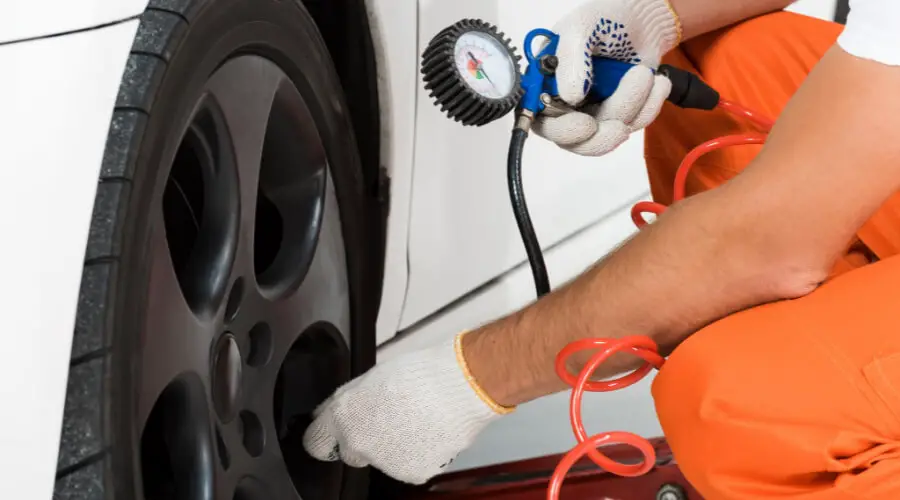Last Updated on December 24, 2022 by Leepu Da Maxim
Well, the ideal tire pressure for a ford fusion ranges between 32 Psi and 39 Psi. However, what will be the perfect tire pressure for your ford fusion depends on quite a few factors like the model, year of the vehicle, type of tires, size of tires, etc. This is why you should check the pressure of the tires stated by the Ford manufacturer for your vehicle.
Key Takeaways
- The appropriate tire pressure is required for the safety, performance, responsiveness, and traction of a Ford Fusion
- According to my years of experience, you should at least check the pressure of the tires twice a month
- You will need a tire pressure gauge to check the pressure of the tires
- You can install Tire Pressure Monitor on your vehicle and it will indicate when you should inflate your tires
How To Check the Tire Pressure of Ford Fusion?
Checking the tire pressure of the Ford Fusion is not that difficult. You will need a tire pressure gauge and a tire inflator to check the tire pressure. Now follow the below steps –
- First, you have to locate the tire pressure recommendations for your vehicle
- You should check the pressure of the tires when the tire is cold because if the tire is hot then it will increase the pressure
- Now, remove the valve cap from the tire you want to check
- Next, insert the tire pressure gauge onto the valve stem
- You will see the current tire pressure on the pressure gauge
- Finally, compare the tire pressure to the recommended pressure for your vehicle stated on the owner’s manual
Ford Fusion Tire Pressure Based on Year Model
According to tire pressure.com, Ford Fusion tire pressure should be as shown in the table below:
Ford Fusion 2020 Tire Pressure
| Tire size | Front Tire Pressure | Rear Tire Pressure |
| 215/60R16 95H | 32psi | 32psi |
| 235/40R19/XL 96V | 37psi | 37psi |
| 235/45R18 94V | 34-35psi | 34-35psi |
| 235/50R17 96H | 36psi | 36psi |
| P225/50R17 93V | 35psi | 35psi |
Ford Fusion 2019 Tire Pressure
| Tire size | Front Tire Pressure | Rear Tire Pressure |
| 215/60R16 95H | 32psi | 32psi |
| 235/40R19/XL 96V | 37 – 39 psi | 37 – 39psi |
| 235/45R18 94V | 34-35psi | 34 – 35psi |
| 235/50R17 96H | 36psi | 36psi |
| P225/50R17 93V | 35psi | 35psi |
Ford Fusion 2018 Tire Pressure
| Tire size | Front Tire Pressure | Rear Tire Pressure |
| 215/60R16 95H | 32psi | 32psi |
| 235/40R19/XL 96V | 37 – 39 psi | 37 – 39psi |
| 235/45R18 94V | 34-35psi | 34 – 35psi |
| 235/50R17 96H | 33psi | 33psi |
| P225/50R17 93V | 35psi | 35psi |
How Do I Know My Tire Pressure is Low?
1. Poor Performance
If you feel your car is performing poorly and experiencing low ride quality, you could have low pressure and should check and deal with it.
2. Tire Pressure Monitor
Suppose your vehicle has a tire pressure monitoring system, and a warning is displayed on the dashboard; that indicates that you should inflate your tires.
3. Tire Pressure Gauge
While checking your tire pressure, remove the valve stem caps on the tires, put a tire pressure gauge into the valve stem, and hold down. This will indicate a PSI reading.
How Does The Tire Pressure Monitoring System Work?
The tire pressure monitoring system determines the pressure in your road tires and displays the readings in your car. You can view the tire pressure readings at the information display. The low-pressure tire warning light will turn on if the tire pressure is low. Once the light is on, your tires are under-inflated and need inflated to the manufacturer’s recommended pressure.
When the light turns on and then turns off shortly, you still need to check your tires. You should note that the tire pressure monitoring system is not a proxy for manually checking tire pressures.
You should often check the pressure using a pressure gauge. Not maintaining tire pressure may increase the risk of tire damage, loss of control, and injury.
How Do I Fix Tire Pressure Sensor Fault On Ford Fusion?

The tire pressure monitoring system is a vital aspect of your car. It illuminates a caution light if any tires are not in good condition. While driving your car, you may notice that your dashboard indicates a ‘Tire Pressure Sensor Fault,’ with a caution light. You should check the tire pressure and add more to the appropriate pressure if this happens.
The quickest way to fix tire pressure sensor faults is to check the pressure of all tires using a good air pressure test. Get the gauges in any parts store and ensure to test the emergency tire- most cars have a force sensor in the spare tire which is normally assumed.
It is appropriate to stick to the recommended tire pressure by the manufacturer because any slight changes may turn on the caution light illumination in the dash. Check the manufacturer’s manual for recommended pressure. You can fix the fault by doing the following:
1. Fix Tire Pressure Sensor
To fix this sensor, you need to check the pressure. If no changes occur after examining and regulating the tire pressure to the required specifications, then you can replace the tire pressure sensor.
To check if your sensor is not working, you can check the dash or use the OBD2 scanner. Although an automotive scan tool will assist you in finding the issue, calling a professional will save time in identifying the defective part.
2. Fixing Procedure
To fix or replace the defective tire pressure sensor, remove the tire from the problematic wheel and exchange the previous faulty sensor with a new one. After fixing the new sensor, fix the tire back and inflate it.
Your car’s computer will have to be reprogrammed to recognize the new sensor; else, it will still send fault signals.
If you cannot fix the tire, it is appropriate to contact a repair shop to be handled by skilled personnel.
3. Reprogramming The Sensor
As mentioned above, you have to reprogram your vehicle’s computer to detect the fixed sensor. Reprogramming will depend on the car’s model and build. Various automobiles require a certain mileage to be set on the changed sensor to detect it by the computer. Other vehicles require reprogramming with the previous scanner that detected the faulty sensor.
Is It Safe To Drive With Faulty Tire Pressure Sensor?
Driving with a faulty tire pressure sensor is not recommended as it can be dangerous. Driving on a deflated tire could make your vehicle pull in one direction, especially the side with the deflated tire. This is dangerous because the driver will not completely control the vehicle.
A faulty tire can result in unbalanced tire wear, which can overwhelm the tire’s structural integrity, especially the sidewall. It can also cause a blowout after the tire is inflated once more. If the tire is flat, it should be replaced because of the damage.
If the pressure is satisfactory in all tires, then the sensor is faulty. An abnormal sensor will involve the driver paying more attention to the pressure in their tires because it cannot read the actual pressure again. Ensure you often check this issue.
Situations That Cause Damage To Your Ford Fusion Tires
Some tires may last for a short time, while others last for long depending on the spent miles. Several factors affect the longevity of your tires; they may include:
1. Driving habits such as emergency braking, driving on damaged roads, and speeding
2. Exposure to grease, oil, or chemicals
3. Not adhering to basic tire maintenance practices
4. Ignoring signs such as noise, vibration, or change in handling
5. Exposure to extreme temperatures such as hot or coldness
6. Road conditions like obstacles, speed bumps, or potholes
7. Physical factors such as wear and tear due to age.
How To Take Care Of Ford Fusion Tires
Check: Make it a routine to check for signs of any wear or damage every time you fuel or wash your car.
Inflate: Tires can lose one pound per square inch (PSI) of air pressure every month. Check your tires every month, especially in the morning, to ensure the tire pressure is at the recommended level.
If you inflate your Ford Fusion car with the recommended tire pressure, it will offer better performance and save you in fuel consumption.
Reference:
https://www.quora.com/What-is-the-ideal-tire-pressure-for-a-Ford-Fusion

Hi, I’m Leepu Da Maxim , a dedicated car enthusiast with over 10 years of experience in this field, and I’m thrilled to share my passion and expertise with fellow car enthusiasts like you. My journey began in my hometown West Jordan, Utah, where my fascination with the mechanics and design of cars sparked at a young age. Over the years, this passion has evolved into a commitment to providing accurate, insightful, and engaging information about all things automotive through CarsAmazing .

